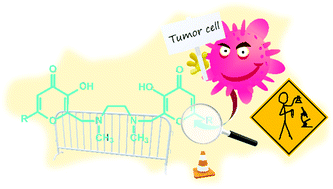Bis-maltol-polyamine family: structural modifications at strategic positions. Synthesis, coordination and antineoplastic activity of two new ligands†
Abstract
Two new maltol-based ligands are presented, L1 (N,N′-bis((3-hydroxy-6-methyl-4-pyron-2-yl)methyl)-N,N′-dimethylethylenediamine) and L2 (N,N′-bis((3-hydroxy-6-hydroxymethyl-4-pyron-2-yl)methyl)-N,N′-dimethylethylenediamine). They were strategically designed by inserting a methyl or hydroxymethyl function at C6, to study the previously hypothesized involvement of that ring position in the anticancer properties and the peculiar metal coordination ability in aqueous solution already shown by this family of ligands. Solid state and solution studies revealed differences neither in the molecular conformation or crystal packing nor in the acid–base behavior compared with the precursor Malten. The introduced substituent groups seem to affect instead both the degradation time (ca. 4–5 h for L1 and L2vs. 10 h for Malten) and the binding properties towards Cu(II), Zn(II) and Co(II), log K values being the highest for L1 within the series of the diamino-bis-maltol ligands. The introduction of –CH2OH at C6 is sufficient to impair the biological activity of the compound and is coherent with the hypothesized mechanism of action.



 Please wait while we load your content...
Please wait while we load your content...